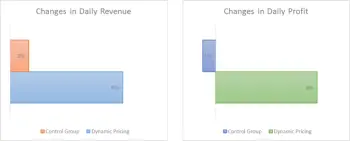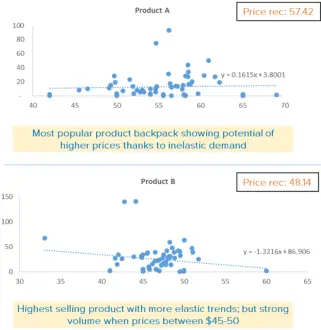3 Tactics to Increase E-commerce Sales
While low-cost retail leaders like Amazon dominate online retail, a race to the bottom can seem like the only way to keep up. After all, Time reports that Amazon owns 23% of online retail market share.

The world of e-commerce is a hyper-competitive space. A/B testing various aspects of the online business is a high-ROI strategy online retailers should focus on to stay competitive.
A/B testing three key areas, pricing, product pages, and product recommendations is pivotal to stay competitive today. Retail giants have mastered these elements and profited greatly. This blog post aims to get other online retailers caught up on these three aspects. Let’s jump into the specifics to see the impact optimization can have for online retailers.
1. A/B test price.
Price influences the consumer’s likelihood to purchase. In fact, 80% of shoppers say that competitive prices drive their purchase decisions. In a crowded market with so much inventory overlap, retailers need to provide effective pricing to be considered. Luckily, retailers don’t always have to present incredibly low prices because value is the other side of price. Shoppers ask themselves, “How much is this product and what am I getting for my money?”
The perfect price is always changing because there’s no such thing as one right price in retail. Would you pay more for ice cream on a summer day than a cold winter one? Probably. You also pay less to see a matinee movie than a Saturday night. Both of these examples translate directly over to online retail. Some key variables that influence pricing are seasonality, time of day, supply and demand, and competitor pricing.
Online retailers can test pricing with a dynamic pricing strategy, which allows them to manually or automatically change their prices based on a number of market and internal forces. Below is a case study that Wiser, a pricing solutions provider for retailers and brands, conducted over the course of five weeks to measure the impact of dynamic price changes.

This study aimed to test elasticity and shows the value of machine learning, which made it possible to try out different prices to optimize for profit dollars. After several weeks of dynamic pricing, the retailer saw a net 5% lift in revenue and 9% lift in profit dollars. Since online retail is such a dynamic space, stagnant prices are often at odds with the state of the market. By regularly changing prices, Wiser’s algorithm was able to continuously optimize on market dynamics and deliver lift to the retailer’s profit dollars.
Further elasticity modeling on top SKUs demonstrated how dynamic pricing was able to optimize price on both inelastic (product A) and elastic (product B) offerings. The x-axis represents price and the y-axis is quantity sold. Automating a way to identify this pricing sweet spot is key in delivering real dollars to the bottom line and increasing the sophistication of any pricing team.

2. Experiment with website layout.
The layout of a site has a huge impact on how likely a shopper is to convert.
Shoppers decide whether they trust the brand and want to stay on a site within seconds. An easy-to-navigate landing page is important to drive conversions. Product and checkout pages are equally important, as more shoppers drop off at every stage in the purchase funnel.
Product pages, in particular, have several components that should be tested. Since shoppers only have reviews, images, and descriptions to decide whether or not the product is a good fit, make it easier for them by providing enough high-quality images, but not so many that it slows down the load time.
3. Test different cross-sells and upsells.
Once a shopper has arrived at the site and added some items to their cart, a retailer’s work is almost done. All that’s left to do is work in cross-sells and upsells — two parts of the experience that can have a big impact on revenue and future loyalty. Amazon is a pro at making spot-on recommendations. Through A/B testing the types of products a retailer is suggesting, any online retailer can significantly boost their average order value.
Sucharita Mulpuru, a leading expert on eCommerce and an analyst at Forrester Research estimates that upsells and cross-sells are responsible for 10-30% of e-commerce revenue. While those are just ballpark figures, it is still clear that cross-selling and upselling are worthwhile pursuits for any retailer that wants to grow their business.
The National Retail Federation predicts that overall retail sales will increase by 4.1% this year, showing the strongest growth in the history of online sales. Non-store sales, which include online retail, will make up a large part of that, with up to 10% growth predicted. In order to capitalize on this massive growth, online retailers must start optimizing the shopping experience. When shoppers can easily navigate a website, see a price that they are willing to pay, and get great recommendations for additional products, there’s no cap on the revenue and profit impact for savvy retailers.
